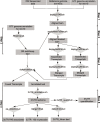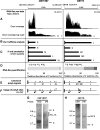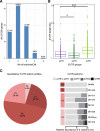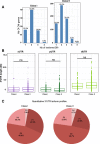Alternative polyadenylation produces multiple 3' untranslated regions of odorant receptor mRNAs in mouse olfactory sensory neurons
- PMID: 31299892
- PMCID: PMC6624953
- DOI: 10.1186/s12864-019-5927-3
Alternative polyadenylation produces multiple 3' untranslated regions of odorant receptor mRNAs in mouse olfactory sensory neurons
Abstract
Background: Odorant receptor genes constitute the largest gene family in mammalian genomes and this family has been extensively studied in several species, but to date far less attention has been paid to the characterization of their mRNA 3' untranslated regions (3'UTRs). Given the increasing importance of UTRs in the understanding of RNA metabolism, and the growing interest in alternative polyadenylation especially in the nervous system, we aimed at identifying the alternative isoforms of odorant receptor mRNAs generated through 3'UTR variation.
Results: We implemented a dedicated pipeline using IsoSCM instead of Cufflinks to analyze RNA-Seq data from whole olfactory mucosa of adult mice and obtained an extensive description of the 3'UTR isoforms of odorant receptor mRNAs. To validate our bioinformatics approach, we exhaustively analyzed the 3'UTR isoforms produced from 2 pilot genes, using molecular approaches including northern blot and RNA ligation mediated polyadenylation test. Comparison between datasets further validated the pipeline and confirmed the alternative polyadenylation patterns of odorant receptors. Qualitative and quantitative analyses of the annotated 3' regions demonstrate that 1) Odorant receptor 3'UTRs are longer than previously described in the literature; 2) More than 77% of odorant receptor mRNAs are subject to alternative polyadenylation, hence generating at least 2 detectable 3'UTR isoforms; 3) Splicing events in 3'UTRs are restricted to a limited subset of odorant receptor genes; and 4) Comparison between male and female data shows no sex-specific differences in odorant receptor 3'UTR isoforms.
Conclusions: We demonstrated for the first time that odorant receptor genes are extensively subject to alternative polyadenylation. This ground-breaking change to the landscape of 3'UTR isoforms of Olfr mRNAs opens new avenues for investigating their respective functions, especially during the differentiation of olfactory sensory neurons.
Keywords: 3′ untranslated region; Adult olfactory mucosa; Alternative polyadenylation; IsoSCM; Odorant receptors; Olfactory sensory neuron; Olfr genes; mRNA isoforms.
Conflict of interest statement
The authors declare that they have no competing interests.
Figures







Similar articles
-
Reprogramming of 3' untranslated regions of mRNAs by alternative polyadenylation in generation of pluripotent stem cells from different cell types.PLoS One. 2009 Dec 23;4(12):e8419. doi: 10.1371/journal.pone.0008419. PLoS One. 2009. PMID: 20037631 Free PMC article.
-
The emerging theme of 3'UTR mRNA isoform regulation in reprogramming of cell metabolism.Biochem Soc Trans. 2023 Jun 28;51(3):1111-1119. doi: 10.1042/BST20221128. Biochem Soc Trans. 2023. PMID: 37171086 Free PMC article. Review.
-
3'UTR Diversity: Expanding Repertoire of RNA Alterations in Human mRNAs.Mol Cells. 2023 Jan 31;46(1):48-56. doi: 10.14348/molcells.2023.0003. Epub 2023 Jan 20. Mol Cells. 2023. PMID: 36697237 Free PMC article. Review.
-
Alternative polyadenylation in the regulation and dysregulation of gene expression.Semin Cell Dev Biol. 2018 Mar;75:61-69. doi: 10.1016/j.semcdb.2017.08.056. Epub 2017 Sep 1. Semin Cell Dev Biol. 2018. PMID: 28867199 Review.
-
Alternative cleavage and polyadenylation in spermatogenesis connects chromatin regulation with post-transcriptional control.BMC Biol. 2016 Jan 22;14:6. doi: 10.1186/s12915-016-0229-6. BMC Biol. 2016. PMID: 26801249 Free PMC article.
Cited by
-
Dynamic Variations of 3'UTR Length Reprogram the mRNA Regulatory Landscape.Biomedicines. 2021 Oct 28;9(11):1560. doi: 10.3390/biomedicines9111560. Biomedicines. 2021. PMID: 34829789 Free PMC article. Review.
-
Expert curation of the human and mouse olfactory receptor gene repertoires identifies conserved coding regions split across two exons.BMC Genomics. 2020 Mar 3;21(1):196. doi: 10.1186/s12864-020-6583-3. BMC Genomics. 2020. PMID: 32126975 Free PMC article.
-
Generation of Transcript Length Variants and Reprogramming of mRNA Splicing During Atherosclerosis Progression in ApoE-Deficient Mice.Biomedicines. 2024 Nov 26;12(12):2703. doi: 10.3390/biomedicines12122703. Biomedicines. 2024. PMID: 39767610 Free PMC article.
References
-
- Shepherd GM. The olfactory glomerulus: its significance for sensory processing. In: Katsuki Y, Norgren R, Sato M, editors. Brain mechanisms of sensation. New York: Wiley; 1981. pp. 209–223.
-
- Buck L, Axel R. A novel multigene family may encode odorant receptors: a molecular basis for odor recognition. Cell. 1991;65:175–187. - PubMed
-
- Chess A, Simon I, Cedar H, Axel R. Allelic inactivation regulates olfactory receptor gene expression. Cell. 1994;78:823–834. - PubMed
MeSH terms
Substances
Grants and funding
LinkOut - more resources
Full Text Sources

